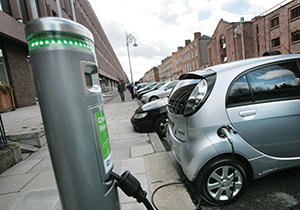The coming age of electric vehicles
 Graham Brennan from the Sustainable Energy Authority of Ireland looks at the impact of improvements in battery technology on the continuing rise of the electric vehicle.
Graham Brennan from the Sustainable Energy Authority of Ireland looks at the impact of improvements in battery technology on the continuing rise of the electric vehicle.
Motor transport is a difficult area to address in terms of efficiency and emissions because of the dominance of the Internal Combustion Engine (ICE) and the reliance on petrol or diesel to fuel it.
The advent of laptop computers in the 1980s and portable electronic devices created a need for high energy density batteries. Lithium was known to offer one of the highest voltage potentials available offering peak battery cell voltages of 4V. This contrasted dramatically with cell voltages of 2V for a lead acid battery. Therefore a lithium battery could transmit up to twice the energy per electron charge delivered. Additionally, with lead being such a heavy element, the first generation of lithium ion batteries in practise were able to offer three times the energy density of lead batteries.
The automotive industry, under pressure to reduce emissions, realised that they could now begin to consider Electric Vehicles (EVs i.e. Plugin Hybrid Electric Vehicles PHEV and Battery Electric Vehicles BEV (see Figure 1) which could hold enough energy to propel a vehicle of sufficient size and performance to meet the expectations of a motorist.
A key argument made by critics of the EV is that it does not actually reduce emissions when the CO2 contained in the electricity is accounted for. The CO2 intensity of the electricity system in the Republic of Ireland in 2013 was 469g of CO2 per kWh (or unit) of electricity supplied to the consumer. The electrical system efficiency in 2013 was 48 per cent with the remaining energy lost in thermal energy in the generators, power consumed to run the power plant and electricity transmission system losses.
Using these numbers we can estimate the CO2 footprint for a Nissan Leaf operating on this electricity supply to be 70g/km. This can be contrasted with the stated emission figures for a brand new Toyota Auris 1.4 litre diesel of 99g/km. Similarly when considering the energy involved in creating and transmitting the electricity, it can be shown that overall the Leaf uses 18 per cent less energy than the diesel car.
However, this is not the real prize offered by EVs. The more wind, photovoltaic and ocean energy we can harness, the cleaner the electricity system becomes and the less energy we need to import for our transport requirements. If the proposed targets on renewables can be met for instance, EVs operating in 2020 could potentially cause imports of fossil fuels to reduce by 40 per cent when compared with their diesel counterparts.
Figure 2 shows the indicative energy density for a range of batteries currently available in the market. The Nissan Leaf battery is estimated to have an energy density of 100Wh/kg with the Tesla battery estimated to be higher at 225Wh/kg. If we consider that the Leaf has a range of 200km, by switching chemistries to match the levels offered by the Tesla battery, the Leaf could be expected to have a range of 400km for the same mass of batteries as it has today. Tesla already offer a 500km vehicle and Audi recently announced the development of an all-electric SUV with an expected range of 500km with a launch date of 2018. Looking further ahead, currently available Li-Sulphur batteries offer even higher energy densities which could see affordable vehicles with a 600 km range become a reality before the end of the decade. In a country the size of Ireland, a vehicle with a 300 km to 600 km range offering substantial energy cost savings will become a very attractive proposition to the consumer here.
In terms of battery life, the bigger the energy storage size of the battery, the fewer the number of full charging cycles it undergoes each year for the same annual km driven. While there are ad-hoc and unofficial tests which seem to confirm Nissan and Tesla’s claims with respect to battery life, a formal test standard is now required to provide assurance and transparency to the consumer. However, it does appear that there will be sufficient battery life not only to meet the life time of the vehicle but also to provide additional services such as buying electricity for the home at cheap times and supplying reserve electricity to the network in exchange for payment.
In our earlier example of the Leaf and Auris, the EV owner purchases relatively few units of electrical energy and there is no fuel duty on this electricity.
Therefore we find that the energy cost for the EV is 1.3 cents/km and that of the diesel vehicle is 4.9 cents/km resulting in a typical energy cost saving of 70 per cent. So while the energy cost savings are clear incentives for the consumer to switch to electric drive, the relatively high capital costs will put many interested consumers off making that change right now. But progress is being made here also. From 2011 to 2013 the price of the Nissan Leaf fell by almost €10,000 when the production plant in Sunderland commenced operation. Competition is also starting to have an impact with over 11 EV models currently available. It is estimated that battery manufacturing costs are already €300/kWh today and are predicted to reach €150/kWh by 2020.
The majority of vehicle charging is expected to take place at the home via an AC plug (one phase). It is likely that during regular commuting journeys there will be limited requirement for access to public chargers. For longer journeys, there is a need for public infrastructure to allow cars to be charged while parked in the town or while in transit to a destination. In the case of street or car park charging, these chargers also offer AC charging (three phase). DC fast charging offers much higher power levels which can charge a vehicle to 80 per cent of its capacity within 20 minutes. There are approximately 90 of these DC fast chargers installed in Republic of Ireland and 19 in Northern Ireland at present.
In addition to these, there are 34 AC fast chargers in the Republic of Ireland and seven in Northern Ireland. As EV driving ranges increase, the demand for these chargers will rise steadily. While the majority of chargers at present are funded by grants or levies on electricity consumers, it is expected that a growing commercial opportunity will emerge for motorway petrol stations, shopping centres etc. in order to support the long term investment needed for this infrastructure.
EU Regulations and labelling on vehicle CO2 have worked effectively to encourage consumers to purchase and manufacturers to produce more energy efficient cars with lower CO2 emissions. However, as this has also implied a trend towards greater use of diesel fuels across Europe, other emissions have risen significantly in response. Correcting this imbalance is likely to see the emergence of petrol fuelled plugin electric and fully electric vehicles in Europe.
In the Republic of Ireland today there are nearly 1,100 EVs on the road with sales rising by a factor of two in 2015. EV battery range and life are improving steadily with the prospect of an affordable 600km range vehicle by 2020 looking possible. Given our mild climate, island geography and excellent renewable energy resources, the EV will meet the requirements for the Irish consumer sooner than they will for consumers in other countries with more extreme seasonal changes. With its exceptional energy cost savings, the EV may be poised to one day become the vehicle of choice for the Northern Irish motorist.
Graham Brennan is Transport Programme Manager at the Sustainable Energy Authority of Ireland.





